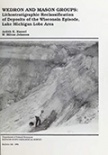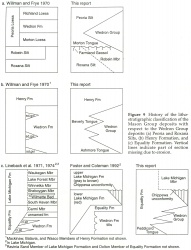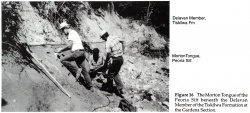Historical:Morton Tongue
Lithostratigraphy: Mason Group >>Peoria Silt >>Morton Tongue
Chronostratigraphy: Cenozoic Erathem >>Quaternary System >>Pleistocene Series
Authors
Ardith K. Hansel and W. Hilton Johnson
Name
Original description
Morton Loess (Frye and Willman 1960).
Derivation
Morton, a village in Tazewell County, central Illinois.
History/background
In 1960, Frye and Willman applied the term Morton to the loess that occurs stratigraphically above the "Farmdale silt," which they later (Willman and Frye 1970) named the Robein Silt, and below the "Shelbyville till" (Wedron Formation of Willman and Frye 1970). Before 1960, the Morton Tongue was called the "Iowan loess" (Leighton 1933, Leighton and Willman 1950), but Frye and Willman (1960) maintained it required a separate lithostratigraphic name because radiocarbon evidence indicated it was at least 15,000 years younger than the type "Iowan" of Iowa. In this report, the Morton Loess is classified as the Morton Tongue of the Peoria Silt (fig. 9a); it is the lower tongue of the Peoria Silt that extends below the Tiskilwa Formation of the Wedron Group.
Type section
Farm Creek Railroad Cut Section, located 9.6 kilometers (6 mi) northwest of Morton. No longer exposed.
Reference section
Farm Creek Section, Gardena Section (fig. 16), Glendale School Section, Danvers Section; all good for lithology and contacts.
Stratigraphic relationships
The Morton Tongue is the Peoria Silt that extends beneath the Tiskilwa Formation of the Wedron Group.
The underlying Robein Member of the Roxana Silt is usually leached of carbonates, stratified, and more organic rich than the Morton Tongue. The silt of the Morton Tongue is readily distinguishable from the overlying coarse grained sediment of the Ashmore Tongue and the diamicton units of the Delavan Member and undivided Tiskilwa Formation. In contrast to the fine grained sediment of the Peddicord Tongue, silt of the Morton Tongue generally lacks bedding structures.
Extent and thickness
The Morton Tongue is a subsurface, wedge-shaped unit that occurs in a belt about 50 kilometers (31 mi) wide in the up-ice direction from the western and southern margin of the Wedron Group. It is generally less than 2 meters (6.6 ft) thick and pinches out beneath the Tiskilwa Formation to the north and east (Kempton and Gross 1971).
Lithology
The Morton Tongue consists of gray to yellow tan, dolomitic, fossiliferous silt that is generally unbedded but is locally organic-rich. At the Gardena and Danvers Sections, it contains a thin organic layer, including an in situ moss bed in the upper few centimeters. Locally, the Morton Tongue also contains stratified layers of peat, muck, and wood, which have yielded radiocarbon ages ranging from about 26,000 to 20,000 years old (appendix B2).
Contacts
Lower boundary: the gradational to fairly abrupt contact with the Robein Member of the Roxana Silt or the contact with older units. Upper boundary: the contact with the Ashmore Tongue (Henry Formation), the Peddicord Tongue (Equality Formation), the Delavan Member (Tiskilwa Formation), or the undivided Tiskilwa Formation.
Fossils
The fossil content consists of dispersed pulmonate gastropod shells that are often crushed and fragmented.
Age and correlation
The Morton Tongue was deposited during the early part of the Michigan Subepisode between about 26,000 and 20,000 radiocarbon years ago. It is laterally equivalent with the lower part of the Peoria Silt in the area beyond the Wedron Group boundary and with part of the Atherton Formation (Wayne 1963) in Indiana.
Environments of deposition
The Morton Tongue is proglacial loess that was deposited beyond and later overridden by the advancing Michigan Subepisode glacier. The loessal silt was derived primarily from the Illinois (ancient Mississippi) River valley.
Remarks
Revised unit. Downgraded in rank to a tongue of the Peoria Silt and name changed to the Morton Tongue.
References
FRYE, J. C., and H. B. WILLMAN, 1960, Classification of the Wisconsinan Stage in the Lake Michigan Glacial Lobe: Illinois State Geological Survey Circular 285, 16 p.
KEMPTON, J. P., and D. L. GROSS, 1971, Rate of advance of the Woodfordian (Late Wisconsinan) glacial margin in Illinois— Stratigraphic and radiocarbon evidence: Geological Society of America Bulletin, v. 82, no. 11, p. 3245-3250.
LEIGHTON, M. M., 1933, The naming of the subdivisions of the Wisconsin glacial age: Science, v. 77, no. 1989, p. 168.
LEIGHTON, M. M., and H. B. WILLMAN, 1950, Loess formations of the Mississippi Valley: Journal of Geology, v. 58, no. 6, p. 599-623. (Reprinted as Illinois State Geological Survey Report of Investigations 149)
WAYNE, W. J., 1963, Pleistocene Formations of Indiana: Indiana Geological Survey Bulletin 25, 85 p.
WILLMAN, H. B., and J. C. FRYE, 1970, Pleistocene Stratigraphy of Illinois: Illinois State Geological Survey Bulletin 94, 204 p.
ISGS Codes
| Stratigraphic Code | Geo Unit Designation |
|---|---|


